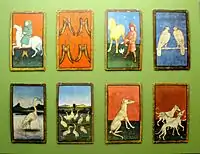
The Ambraser Hofjagdspiel (Court Hunting Pack of Ambras), also called the "Ambras falconer cards",[1] is a pack of cards painted around 1440–1445 and attributed to the engraver Konrad Witz from Basle, Switzerland.[2] It originally consisted of fifty-six cards from which only 54 survive, all distributed in four suits, falcons, lures, hounds and herons, symbols related to hunting.[2] Each suit contained ten pip cards with the 10s being represented by a banner like many old German playing cards and modern Swiss playing cards. There are four face cards per suit: the Unter, Ober, Queen, and King. It was found in a collection at the Ambras Castle, in Innsbruck, Austria, in the sixteenth century, and now figures as a precious item in the collection of cards of the Kunsthistorisches Museum (Museum of Art History) in Vienna.[3]
Facsimile
A facsimile of the pack was produced as a boxed set in 1995 by Piatnik in conjunction with the Kunsthistorisches Museum. It makes no attempt to reproduce the missing two cards of the original pack.[4][5]
See also
- Flemish Hunting Deck, another 15th-century hunting deck
- Stuttgarter Kartenspiel, another 15th-century hunting deck
- Hofämterspiel, a deck found together with the Hofjagdspiel in Ambras Castle
References
- ↑ Hurst, Michael J. "Collected Fragments of Tarot History". The Arcane Archive. Retrieved 2 July 2012.
- 1 2 The World of Playing Cards. "The Ambras Court Hunting pack, c. 1445". WOPC. Retrieved 2 July 2012.
- ↑ Bialostocki, Jan (1998). El Arte Del Siglo XV: De Parler a Durero (in Spanish). Ediciones Akal. p. 205. ISBN 847-090-347-0.
- ↑ Kunsthistorisches Museum Wien at khm.at. Retrieved 18 Feb 2022.
- ↑ Ambraser Hofjagdspiel at piatnik.com. Retrieved 18 Feb 2022.